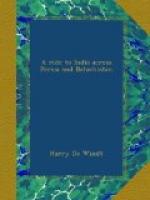About midday, to my great surprise, Malak made his appearance in person, mounted on a good-looking chestnut stallion, its bridle and saddle adorned with gold and silver trappings. Four attendants followed on sorry-looking steeds. The chief, a tall, well-built fellow, about thirty years of age, with a sulky, sinister cast of countenance, was clad in a bright green satin jacket, white and gold turban, loose dark-blue trousers, and embroidered slippers. The loss of one eye gave him a still more unpleasant expression, a lock of coarse black hair being dragged over the face to conceal the disfigurement. The whole party were armed to the teeth, and carried guns, shields, and revolvers.
Our interview did not commence propitiously. Swinging himself off his horse, Malak returned my salutation with a sulky nod, and swaggered into the tent, signing to his suite to follow his example. Curtly refusing my offer of refreshment, he called for his pipe-bearer, and, lighting a kalyan, commenced puffing vigorously at some abominably smelling tobacco, which soon rendered the interior of the tent unbearable. It is, unfortunately, Baluch etiquette to allow a guest to open the conversation. Malak, well aware of this, maintained a stolid silence, and appeared hugely to enjoy the annoyance and impatience I tried in vain to conceal. It was not till nearly an hour had elapsed that this amiable visitor at last inquired, in a rude, surly tone, what I wanted. My interpreter’s services were then called in, but it was not without demur and a long consultation with his suite that Malak consented to accompany me to Gwarjak on the morrow. Matters were finally arranged, on the understanding that I did not remain more than one day at Gwarjak, but proceeded to Kelat without delay.
I strolled out with a gun in the evening, and managed to bag a brace of partridges, which swarmed in the maize and barley fields. Overcoming the fears of the women, I was permitted to approach and inspect, though not enter, one of their dwellings. The latter, constructed of dried palm leaves, were about fifteen feet long by eight feet broad, and were entirely devoid of rugs, carpets, or furniture of any kind, and indescribably filthy. The men, though shy and suspicious, would have been friendly, had it not been for Malak, who followed me like a shadow; but nothing would induce the women and children to approach either Gerome or myself. “What is this?” said one old fellow to Malak, stroking my face with his horny, grimy palm. “I never saw anything like it before.” Most of the men were clothed in dirty, discoloured rags. The women wore simply a cloth tied loosely over the loins, while male and female children fourteen or fifteen years old ran about stark naked.
A curious flower, the “kosisant,” grows luxuriantly about here. It is in shape something like a huge asparagus, and about two feet high, being covered from top to bottom with tiny white-and-yellow blossoms, with a sweet but sickly perfume. It consists but of one shoot or stalk, and bursts through the ground apparently with great force, displacing the soil for several inches.




